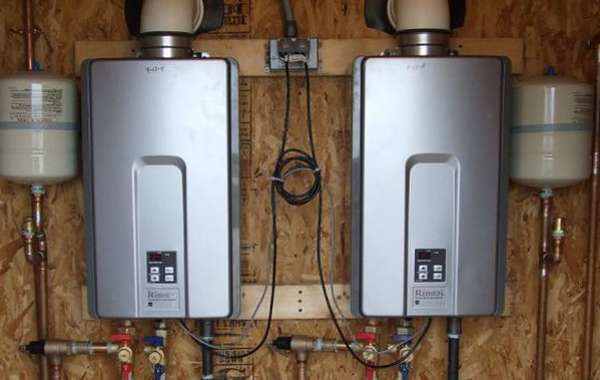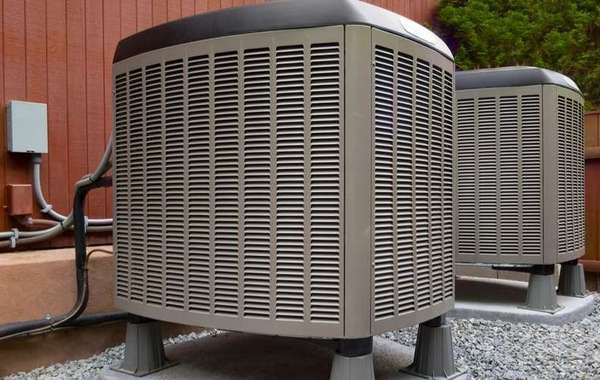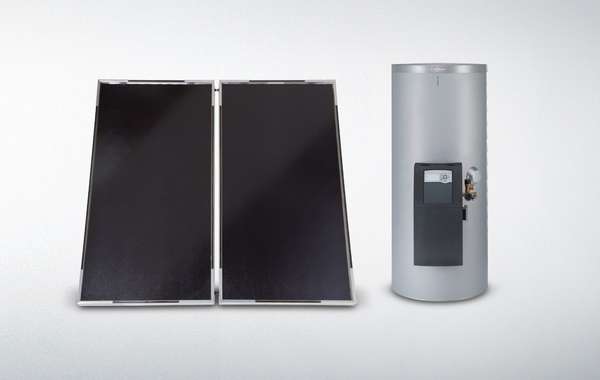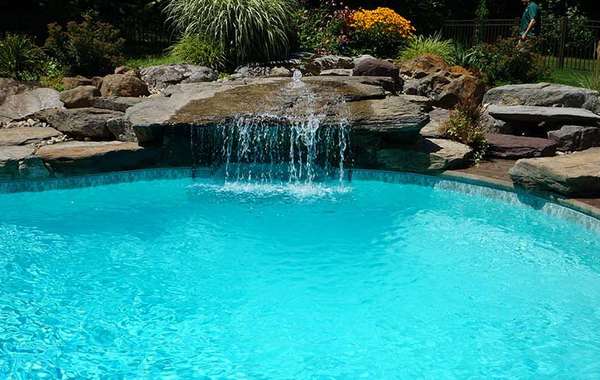There are many manufacturers of heat pump water heaters on the market, which, rather than heating water with an electric coil as a normal electric hot water tank does, employ an evaporator to extract heat from the air (either interior or exterior) and use it to make hot water.
The byproduct of an air-to-water heat pump after it extracts heat is cold air, so with systems that draw from and exhaust air back into the house, they actually act to cool your house in summer, which is a good thing. During heating months, that cold air ejected back into your living space while water is heated simply means that whatever you use to heat the air in your house now indirectly heats your water as well.
This changes the heat source of your hot water from being the hydro electric pole (or natural gas line) that feeds your house to being your air heating system, and this is why it is so crucial to be equipped with a very efficient heating system when making your domestic hot water with a heat pump that draws heat from inside the home.
To explain that further - if you heat your home with an oil furnace, a heat pump water heater that transfers heat from the ambient air in the room to the hot water tank is not such a great idea, as your domestic hot water would then be heated by burning oil. And it won't save you much money, if any, so in that case it's an expensive machine that's very likely doing more harm than good.
If you heat the air of your house with an air-to-air heat pump then they can be a great idea, provided that the evaporator is not restricted to a small mechanical room with little access to the air—and energy—from the rest of the house.
Then comes super-efficient technologies:
Alternatively, a water heating system like the SANC02 from Japanese manufacturer SANDEN, has an exterior compressor, not unlike most air-to-air heat pumps. An exterior-compressor heat pump water heater does not interact in any way with interior air. In this particular case, the CO2 refrigerant extracts heat from the outside air and transfers it to the water, which is then stored in the tank inside your home.
The SANC02 is the first heat pump water heater with an exterior compressor to hit the Canadian market. It's important to note that heat pumps work more efficiently with warmer temperatures. Not only will they have a bottom functional temperature, but as they draw heat from the air, the hotter the air is the less hard they must work.
To be able to easily compare the performance of different heat pumps it would also be useful to read this guide on how to understand the difference between SEER v HSPF v COP (& SCOP) heat pump rating systems.
 |
|
© Sanden
|
When heat pumps work best:
If you live in a climate which will regularly drop below the manufacturers stated functional temperature for their units, there will be times when you will not be able to heat water (or even air in the case of air-to-air heat pumps). Once they reach their bottom end temperature, they will still work but just with very little advantage over a traditional electric resistance water heater, and it would take longer to regenerate hot water after a shower than it would at warmer temperatures. As it gets even colder, they will eventually shut off altogether to prevent damage.
In warmer climates like southern Ontario or the southern coastal regions of BC, you don't have as great a concern with outdoor winter temperatures, but in northern climates heat pumps may need to be accompanied by backup heating coils for when the temperature drops below their functional operational levels. This would mean that their value would go down in such a climate due to the additional equipment required, as well as the overall reduced efficiency they would experience at lower exterior air temperatures.
Fortunately, the SANCO2 will operate at temperatures as low as -29 °C, which means it will not require a backup heating coil even for the Montreal-Ottawa corridor, which in practice, rarely ever sees temperatures below -26 °C. This unit will actually provide 3.5 kW of heat even at -25 °C, with an efficiency of 170%. Its overall efficiency over the whole year, based on the hot water consumption of a family of four each taking an 8 minute shower every morning with a regular shower head delivering 9.5 L/min, would be about 340%. In real terms, that translates into water than is heated 3.4 times more efficiently than you are used to, which is quite impressive.
In a more moderate climate like Toronto, the performance would be even better and the risk of running out of hot water virtually eliminated.
Size matters:
The SANCO2 comes with a 43 or 83-gallon (163 or 314 L) storage tank. As the speed at which it can generate hot water will slow at very low temperatures, it might be wise to opt for the bigger tank in colder climates to reduce any risk of running out of hot water, depending on family size and hot water usage.
What we like about the SANC02:
- Very low operating temperature without the need for electric backup,
- CO2 as refrigerant with lower GWP (global warming potential)
- Two sizes of water storage tank to better fit the needs of consumers
- High delivered water temperature (65° C)
What we don't like about the SANCO2:
That's a pretty easy answer - the price.
The Vancouver distributor sells the outdoor unit for $3,227, a 43 gallon tank for $2,253 and the 83 gallon tank for $2,457. Keep in mind, that's before the cost of installation. Contractor prices are a bit lower, but you probably won't see any benefit from that, so you're still looking at an easy $7,000 to have one installed, which we find a bit steep.
To find a return on investment period, we ran the numbers based on Quebec hydro rates (among the lowest in Canada but at least consistent); here is what we found:
A family of four would on average consume about 70,000 L of 60 °C hot water per year, which would require 4,000 kWh to produce at the average annual inlet temperature of 10 °C. At about 8¢ per kWh, this would normally cost $320 per year. With an average COP of 3.4, the annual cost with a SANCO2 would be about $95, for a yearly savings of $225 over a traditional hot water heater.
With an installed cost of $7,000, it would then take 31 years to recuperate your investment, which is longer than the lifetime of the system. Savings would be a bit higher in regions with higher rates, but it's still beyond justification at the current price. The only way this would make sense would be for high rate payers that use larger quantities of hot water during peak hours. We love the technology, but not at the current price.
Interior compressor units:
The SANC02 is the only exterior compressor unit available in Canada, but there are several interior compressor units on the market. These are the ones that we mentioned at the beginning that draw air from the conditioned space rather than the exterior. They can be a great idea, but under slightly more specific circumstances.
As long as you can vent the cold exhaust air from the unit to the main living areas, they can be quite advantageous in summer as they will remove a lot of hot air from the home, so you get a certain amount of 'free air conditioning'.
They stop being such a great idea if they are in a small unventilated mechanical room, as they will cool that space and act to reduce their own efficiency.
Another possible downside would be added noise. An interior compressor can be a bit noisier, so be careful about where you install them to make sure they don't pollute your home with egregious decibels.
Also, as mentioned above, they are only as efficient as the air you offer them. If the energy grid in your region is fed with renewable energy but you heat your house with fossil fuels, in winter months you would now be heating your water with fossil fuels. They work best and reduce your carbon footprint when combined with a clean source of interior air, like an air source heat pump. If you're thinking of a Geothermal heating system and comparing them to ASHP's heat pumps, take a read here.
Now you know about efficient residential heat pumps, learn more about home heating and energy efficiency solutions in the following pages and in the EcoHome Green Building Guide.
Find more about green home construction and reap the benefits of a free Ecohome Network Membership here. |

























A builder I know tried the Sanden and told me the water pipes from the outdoor unit turned to ice and were not covered by warranty because of fine print that requires heat tape that works during power failures. It is OK in Australia where they place the tank outdoors, but not suited for Canada. It only suits a design temp of -5 C and heating load under 1.8 kW (8000 BTU), which is even too little for a passive house in Victoria. Forget the CO2 as well, no HVAC person can service these units in the field, they have to be replaced by shipping back East near Boston at your expense plus return. Forget this.
Could this hot water system provide enough heat to warm a home comfortably (radiant in floor heating), and DHW? Maybe two large tanks, one outdoor unit to look after the homes needs.
Wouldn't we all be better just getting tankless water heaters? It seems a waste of energy to me to keep this big tank of hot water all the time when you could just use it when you need it with on demand water.
Hi John,
New water heaters are pretty well insulated, and keep in mind that in cold climates, the losses are only losses in the summer months. In the north where you may be heating for 7-8 months of the year, its not a loss because that heat will warm your home.
About tankless water heaters - they do have their place, specifically in very small homes where there simply isn't room, and I would also say for cottages when you don't go enough to make efficient use of a water heating tank. And with a summer cottage you wouldn't even benefit from the losses to the home, as you wouln't really have a need for the heat.
And for electric tankless heaters there is an added consideration - they lay dormant without consuming electricity until you turn on a tap, at which point they consume a ton of it. So for electric on demand water heaters, if we all had them then there would be a massive spike in electrical consumption at peak water heating hours like before and after work. So it's not a problem because there aren't that many (at least electric that we know of) but if there were then that consumption would cause some sizable headaches for regional power suppliers to keep us all juiced up.
here is our page about tankless water heaters and you can see if they are right for you.
Tankless heaters fur up and have to be replaced every 5-10 years. Figure this in when considering cost and environmental point of view
If it was also acting as a heat pump for heating the home, an higher price would be acceptable. If there such heat pump that can heat the home and the water?
This is a smart idea! I reiterate your question hoping someone can answer this. We have the technology on both ends (heating air and heating water with heat pump). Now has a company combined both or is it even possible?
I posed this very question to the manufacturer. At just 15K BTU they say the heat pump is really only suitable for a small, efficient space, if used in this role.
The ancient dependable coal converted to natural gas boiler in our 1936 house is gone. We are installing a natural gas boiler for the oringinal excellent hot water radiators in the house plus 2 multi-zone minisplit units, primarily for a/c but also to enhance zone controlled heat as a bonus in th eshoulder season. Time to improve the domestic water heating system. We currently have a natural gas, traditional 40 gallon tank that is in the farthest point of our home from all hot water taps, laundry, kitchen and bathrooms. Yes, the tank is near the gas meter and in the same room as the main water valve. Currently, one waits through many gallons of cold water before the hot water arrives in the taps,....sometimes 2x - 3x in a day. Simplest solution? Move the water water heater, extend the natural gas lline and replumb the water supply line in the basement over below the "stack" of assorted plumbing locations or.....? Using the new IBC Boiler Model SL 14-115G3NG with the IBC-1WT40 indirect 40 gal tank is suggested by our HVAC Pro. Won't that mean the boiler will be on in the hot summer months cancelling out savings? What domestic hot water system could be better for this house? Thanks